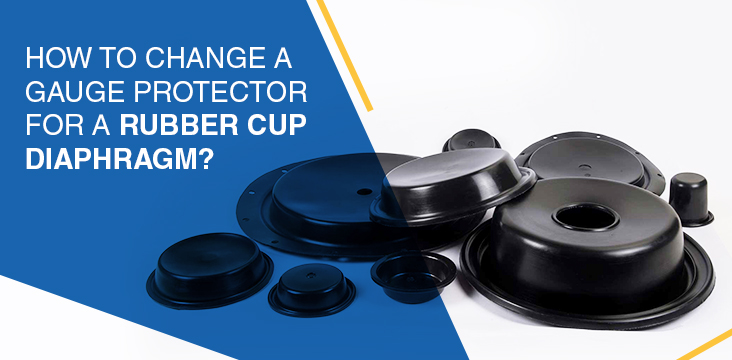How to Change a Gauge Protector for a Rubber Cup Diaphragm?
The regular maintenance of gauge protectors is crucial to ensure they successfully fulfill their purpose of sensing pressure, smoothly. The purpose of the rubber cups is to sense this pressure and protect sensitive gauge internals from harsh drilling fluids, mud or cement. Regular maintenance of this gauge protector promises a lengthy stress-free service in the field.
The gauge protector comes with a rubber cup diaphragm. The rubber cups protect the gauge internals from harsh drilling fluids and senses pressure to transmit it to the gauge. When the rubber cup becomes worn, damaged, or blown, it will need to be replaced.
If a diaphragm cup (sometimes called a bladder) wears or blows, it could harm the bourdon tube and/or movement as the drilling fluids can enter the gauge. Inspecting the rubber cup during regularly scheduled maintenance will prolong the life of the gauge.
How to Check If The Rubber Diaphragm Needs A Replacement?
Begin with checking the diaphragm cup’s round end. If there is a small hole in this area, the system will consequently lose fluid and fill with air instead. If the system has been compromised, the rubber cup sides will fill up like a balloon, in turn, allowing the drilling fluids into the system. When examining the system make sure that the retainer nut is flush with the housing. If the retainer nut is not flush, the diaphragm cup will display a cut on the lip. If cuts, wear, or tears are found on investigation then it’s time to replace the diaphragm cup.
Important Safety Notice
Given that we couldn’t possibly assess every factor or the outcome of the investigation, some warnings against the use of specific service methods stated in these methods /guide can damage the equipment or render them unsafe or could have possible hazardous consequences. Keeping this in mind, we urge you to read further.
What You’ll Need
1.Needle Nose Pliers
2.Retainer Nut
3.Screwdriver
4.Diaphragm Cup
5.Retainer Nut Wrench
6.Diaphragm Protector
Here is a step by step method of how you can replace a rubber diaphragm in gauge protector:
Step One: Flip the Unitized Mud Gauge (UMG) on the side with the gauge face down in a vice to expose the base of the flange. The gauge should be placed upside down so that the glass stays protected during the removal of the diaphragm.
Step Two: With the help of a 1/2″ ratchet with no socket, place ratchet into the center hole in the bottom of the flange.
Step Three: Loosen the retainer nut which holds rubber diaphragm in place by making use of a ratchet then finish off by loosening the nut by hand and removing it.
Step Four: Slide a flat-head screwdriver between the rubber diaphragm cup and the diaphragm housing wall. Making use of the screwdriver, pull the rubber cup diaphragm away from the wall of the gauge protector housing.
Step Five: On achieving a gap large enough, grab the lower rim of the diaphragm using a pair of needle nose pliers. Pull the diaphragm to remove it. If the diaphragm has ruptured, make sure you replace all the pieces.
Step Six: Turn the gauge back on side to expose the center hole. Insert the new rubber cup diaphragm into housing. Ensure you place the closed-in top into the housing first, with the larger rubber cup opening going into housing last. Secure it into the hole until it fits perfectly. The diaphragm will rest in the grove located near the opening and will give a slight pop when back in place.
Step Seven: Replace the retainer nut and finger tighten it in place. Grease retainer nut threads and lip with silicon-based grease to keep the retainer nut from cutting or tearing the rubber cup diaphragm.
Step Eight: Ensure that the retainer nut is sitting just below the lip of gauge protector housing (below flush). Using a ratchet, tighten retainer nut in place. Make sure you don’t over tighten the retainer. Overtightening retainer nut could potentially reduce gauge accuracy and/or destroy rubber cup diaphragm.
To maintain the life of a gauge, regular inspection and the timely replacement of the rubber diaphragm is essential. With regular maintenance, this gauge protector will successfully provide years of worry-free service in the field.








